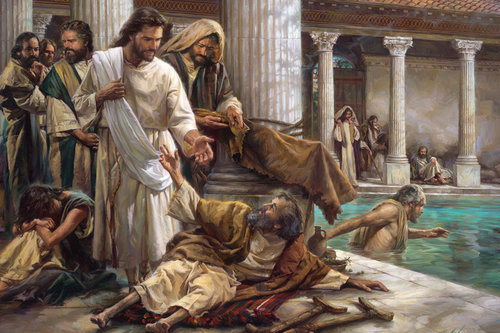The People Needed to Know

It Was A Divine Work!
Jesus was in trouble with the Sanhedrin at Jerusalem. It started with a skirmish about the Sabbath that He had with the Pharisees at Bethesda. It was the time of the Passover, and near the sheep market there was this pool known as the House of Mercy. According to John, a great multitude of impotent folk, of blind, halt, withered, lay in the porticoes surrounding the pool. It is thought that Bethesda was part of the Hellenization of Jerusalem—that it was really built according to the pattern of the Greco-Roman hospitals of the day. In the First Century there were over 400 of these healing temples in the Roman Empire. These were generally sacred to the god Asclepius, and the hospitals were known as asclepeion. The waters of asclepion pools were sacred, they were believed to have curative power. But at Bethesda the superstition seems to have been modified to make them more compatible with Judaism—to include an angel's part—coming from time-to-time to stir the water. This, no doubt, happened when fresh water came into the pool through the piping from the spring.
The practice of going to the hospital to visit the sick on Sabbath afternoon must be an old one. Because that Sabbath, Jesus went to the hospital at Jerusalem to visit the sick. He saw a hopeless old man there. The man had been there for 38 years; and Jesus was moved with compassion for Him. So He healed the invalid; and He did so in a most attention-getting manner. He specifically wanted people to know about it; and He wanted them to distinguish this healing from normal medical practice. When Christ healed a man born blind—also on a Sabbath—He made clay packs for his eyes and sent him to the Pool of Saloam to wash. Referencing this story, the Spirit of Prophecy tells us that Jesus “did not give countenance to drug medication,” but that “He sanctioned the use of simple and natural remedies.” It is significant that the Pool of Saloam wasn't normally associated with healthcare: it was where the priests drew water for use in the sanctuary services; but at Bethesda, Jesus didn't utilize the waters, the cures, or the healing rituals there. He simply told the old man: “Rise, take up thy bed and walk.”
He knew that after caring for this invalid for 38 years the establishment would know who this invalid was. He knew that this healing would attract attention. He knew that carrying the bed on the Sabbath would cause an uproar. But the people needed to know! The invalid at Bethesda wasn't healed by the normal healthcare of the day—This was a divine work!—And the people needed to know! They needed to know that the Spirit of the Lord was upon Jesus. They needed to know that He was anointed to
- preach the gospel to the poor,
- to relieve the oppressed,
- to liberate the captives,
- to heal the afflicted,
- to restore sight to the blind,
- and to reveal to the world the light of truth.
They needed to know that the Sabbath isn't about counting your footsteps. It isn't about strife and debate. It's about:
- loosening the bands of wickedness,
- undoing the heavy burdens,
- freeing the oppressed,
- breaking every yoke.
Its about giving your food to the hungry. Its about bring the poor to your house. It's about putting your clothes on the naked. They needed to know that this is how you make the Sabbath a delight; not by doing your own thing, not by going your own way, not by saying your own words.

